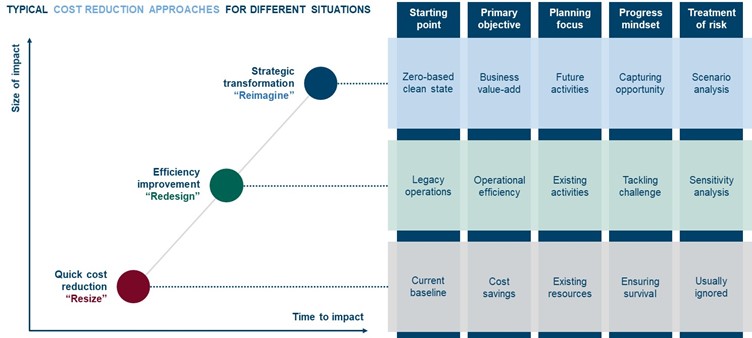How to succeed in strategic cost management now
9.9.2021
The Covid-19 pandemic has affected nearly every industry, but the financial effects have been very uneven. Some industries, like retail and IT, have grown. Others, like transportation, accommodation and restaurant services, have struggled tremendously. Despite all the hardship, one positive trend can be discerned: Many Finnish companies, particularly Finnish industrial companies, have maintained or even improved their profitability despite a net sales drop (see picture 1).
 Figure 1. Net sales and EBIT-% change 2020 vs. 2019 – Finnish public companies
Figure 1. Net sales and EBIT-% change 2020 vs. 2019 – Finnish public companies
How were they able to succeed in their strategic cost management? Based on our observation, there tend to be three primary drivers:
1. Tailored approach
Each company has a unique starting point and different priorities for the future. Thus, one approach cannot possibly fit all. In particular, the approach must align with the company’s cost management targets: magnitude and time horizon for cost savings as well as the need for cost structure flexibility. When savings are needed rapidly, there is limited time to reinvent company’s way of working. Purely resizing existing external spend and workforce to match the current demand might be the most suitable way to go. At the other end of the scale, cost efficiency can also be achieved via profound corporate transformation, but this often means reimagining and building the company’s end-to-end operations to meet future customer needs. This takes time. Consider for example the journey of consumer banks as they move from brick and mortal to online and mobile. Figure 2 demonstrates how the approach and potential benefits must change in each scenario.
 Figure 2. Typical cost reduction approaches for different situations
Figure 2. Typical cost reduction approaches for different situations
2. Long-term play
All costs are not equal. We encourage business leaders to identify their strategic priorities and critical assets and keep these well-funded despite the immediate cost pressure. This is required to secure long-term competitiveness and value add. Some companies, for example, have decided to proceed with their R&D agenda as planned or to keep a top-notch customer experience, despite the heavy savings in other functions and areas.
“At Finavia, we have definitely looked beyond the Covid-19 crisis. We have focused on the most important and strategic projects while postponing 1/3 of our 200 projects. As a key initiative, we have continued Helsinki Airport development program as planned during the crisis to maintain competitive advantage in traffic between Asia and Europe.”
Kimmo Mäki, CEO, Finavia (national airport operator)
In addition, no leader can afford to neglect employee wellbeing or corporate social responsibility. Treating people fairly during the hardest times is not only the right thing to do, it’s economically rational. Leaders’ actions during the crisis have a long-term effect on the motivation of remaining staff and the r brand of the company as an employer.
3. Transform fear into energy
Fear is a natural emotional response for people who are uncertain about the future of their own job or well-being. When fear is the prevailing emotion, organizations tend to get paralyzed, and employees have difficulties in seeing alternative solutions to their problems and taking decisive actions.
We have seen how the most effective business leaders transform fear into energy by engaging people and leading their emotions. This can be done for example by empowering organization into a cross-functional dialogue that typically creates new thinking and novel solutions. To lead the emotional side, those in charge should both acknowledge unpleasant facts and show empathy to people, while providing hope both in communication and through concrete actions.
“I communicated honestly to our staff that we are in a difficult situation, and I understand their daily struggles. I reminded them they arethe most important asset of this company, and stress that nobody’s employment will be terminated, and that we will rise again. My message was supported by concrete actions to take care of employees, and strategic investments into new locations despite the hardship.”
Aku Vikström, CEO, NoHo Partners
By engaging people and leading their emotions, emphasizing long-term play and tailoring cost management approach to the situation at hand, companies can overcome short-term cost pressure without sacrificing their long-term competitiveness. As a consultancy with roots deep in the Finnish economy, we trust that the cost management actions taken by leaders of Finnish corporations in 2020 (remember Picture 1) will payoff a long time into the future..
Examples from Finavia and NoHo Partners are based on Kimmo Mäki’s (Finavia CEO) and Aku Vikström’s (NoHo Partners CEO) presentations in a co-hosted webinar with August on June 10, 2021.
